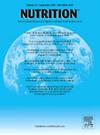在健康老年人单剂量摄入13C-DHA后,补充Omega-3可增加13C-EPA动力学,但不能增加13C-DHA动力学:一项二次分析
IF 3.2
3区 医学
Q2 NUTRITION & DIETETICS
引用次数: 0
摘要
目的考虑到13C-DHA是DHA向组织中最主要的两个输送池,研究补充后是否比补充前更少地进入血浆磷脂(PL)和甘油三酯(TG)。方法对年龄和体质指数相匹配的20名健康男女的血浆样本进行分析。参与者在2个动力学研究中接受单次口服剂量40mg 13C-DHA: 1个在补充3.2 g/天ω3 PUFA之前,1个在补充3.2 g/天ω3 PUFA的最后一个月。在基线、摄入示踪剂后4、6、24小时、7天和28天对血浆样本进行13C富集分析。提取脂质,固相萃取分离PL和TG。碳-13二十碳五烯酸(13C-EPA)和13C-DHA采用气相色谱-质谱(GC-MS)定量。结果13C-DHA在PL和TG中的曲线下面积(AUC)在补充前和补充后无统计学差异。然而,添加后PL和TG中13C-EPA的AUC分别增加了45%和48%。这一发现出乎意料,因为我们之前的分析表明,在补充期间,血浆13C-DHA水平降低了60%,同时β-氧化增加。此外,血浆PL中13C-EPA和13C-DHA的时间×性别相互作用具有统计学意义(P <;0.0001),随着时间的推移,女性的13C-EPA和13C-DHA水平分别高出90%和139%。血浆TG中13C-EPA和13C-DHA没有时间与性别的相互作用,尽管存在独立的时间和性别效应。此外,13C-EPA仅在PL中存在时间与体质指数的交互作用。结论补充ω3 PUFA后,DHA代谢稳定,而EPA代谢可能由于DHA抑制EPA延伸和/或血浆清除率降低等因素而减慢,这可能表明组织对DHA的需求得到了满足。本文章由计算机程序翻译,如有差异,请以英文原文为准。
Omega-3 supplementation increases 13C-EPA but not 13C-DHA kinetics in healthy older adults after 13C-DHA single dose intake: A secondary analysis
Objective
To investigated whether post supplementation, 13C-DHA is less incorporated into plasma phospholipids (PL) and triglycerides (TG) compared to pre-supplementation considering that these are the two most prominent delivery pools of DHA to tissues.
Methodology
Plasma samples from twenty healthy men and women, matched for age and body mass index, were analyzed. Participants received a single oral dose of 40 mg 13C-DHA in 2 kinetic studies: 1 prior to and 1 during the last month of supplementation with 3.2 g/day of ω3 PUFA. 13C enrichment analyses were performed on plasma samples at baseline, 4, 6, 24 hours, 7 days, and 28 days post-tracer intake. Lipids were extracted, and PL and TG were separated by solid-phase extraction. Quantification of carbon-13 eicosapentaenoic acid (13C-EPA) and 13C-DHA was performed using gas chromatography-mass spectrometry (GC-MS).
Results
The area under the curve (AUC) for 13C-DHA in PL and TG did not show statistically significant differences before and during supplementation. However, the AUC for 13C-EPA in PL and TG increased by 45% and 48% with supplementation, respectively. This finding was unexpected, as our previous analysis indicated a 60% reduction in plasma 13C-DHA levels during supplementation, accompanied by increased β-oxidation. Additionally, there were statistically significant time × gender interactions for 13C-EPA and 13C-DHA in plasma PL (P < 0.0001), with women exhibiting 90% and 139% higher levels of 13C-EPA and 13C-DHA over time, respectively. No time × gender interactions were observed for 13C-EPA and 13C-DHA in plasma TG, although independent time and gender effects were present. Furthermore, there was a time × body mass index interaction for 13C-EPA in PL only.
Conclusion
This secondary analysis suggests that after supplementation with ω3 PUFA, DHA metabolism is stable while EPA metabolism may be slowed due to factors such as DHA inhibition of EPA elongation and/or reduced plasma clearance, which may indicate the tissues needs for DHA are being met.
求助全文
通过发布文献求助,成功后即可免费获取论文全文。
去求助
来源期刊

Nutrition
医学-营养学
CiteScore
7.80
自引率
2.30%
发文量
300
审稿时长
60 days
期刊介绍:
Nutrition has an open access mirror journal Nutrition: X, sharing the same aims and scope, editorial team, submission system and rigorous peer review.
Founded by Michael M. Meguid in the early 1980''s, Nutrition presents advances in nutrition research and science, informs its readers on new and advancing technologies and data in clinical nutrition practice, encourages the application of outcomes research and meta-analyses to problems in patient-related nutrition; and seeks to help clarify and set the research, policy and practice agenda for nutrition science to enhance human well-being in the years ahead.
 求助内容:
求助内容: 应助结果提醒方式:
应助结果提醒方式:


